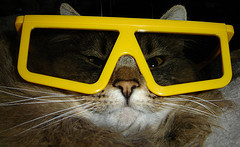Ebert Says 3D Will Never Work Because Our Brains Hate It

(Alaidh)
The massive 3D gimmick the entertainment industry is trying to foist on all of us is going to be about as successful as “Smell-O-Vision,” says film critic Roger Ebert. No, he’s not just just being cranky or “anti new stuff.” Rather, it’s that our brains and eyes are simply not wired for viewing an extended series of 3D images. All the technology improvements and marketing won’t ever beat biology. Here’s why.
Ebert cites a letter sent to him by the extremely respected film editor Walter Murch:
The biggest problem with 3D, though, is the “convergence/focus” issue. A couple of the other issues — darkness and “smallness” — are at least theoretically solvable. But the deeper problem is that the audience must focus their eyes at the plane of the screen — say it is 80 feet away. This is constant no matter what.
But their eyes must converge at perhaps 10 feet away, then 60 feet, then 120 feet, and so on, depending on what the illusion is. So 3D films require us to focus at one distance and converge at another. And 600 million years of evolution has never presented this problem before. All living things with eyes have always focussed and converged at the same point.
Obviously 3D works, otherwise we couldn’t see it. But it’s hard and it gives you a headache because you’re overtasking your brain and eyes. Your eyes are focused on a flat screen 50 feet away but your brain is being told that it is 10 feet away. Your brain does not like being told this, and until we have true Star Trek type holograms, 3D is just another Hollywood ruse destined for the dustbin.
Why 3D doesn’t work and never will. Case closed. [Roger Ebert’s Journal]
Want more consumer news? Visit our parent organization, Consumer Reports, for the latest on scams, recalls, and other consumer issues.

